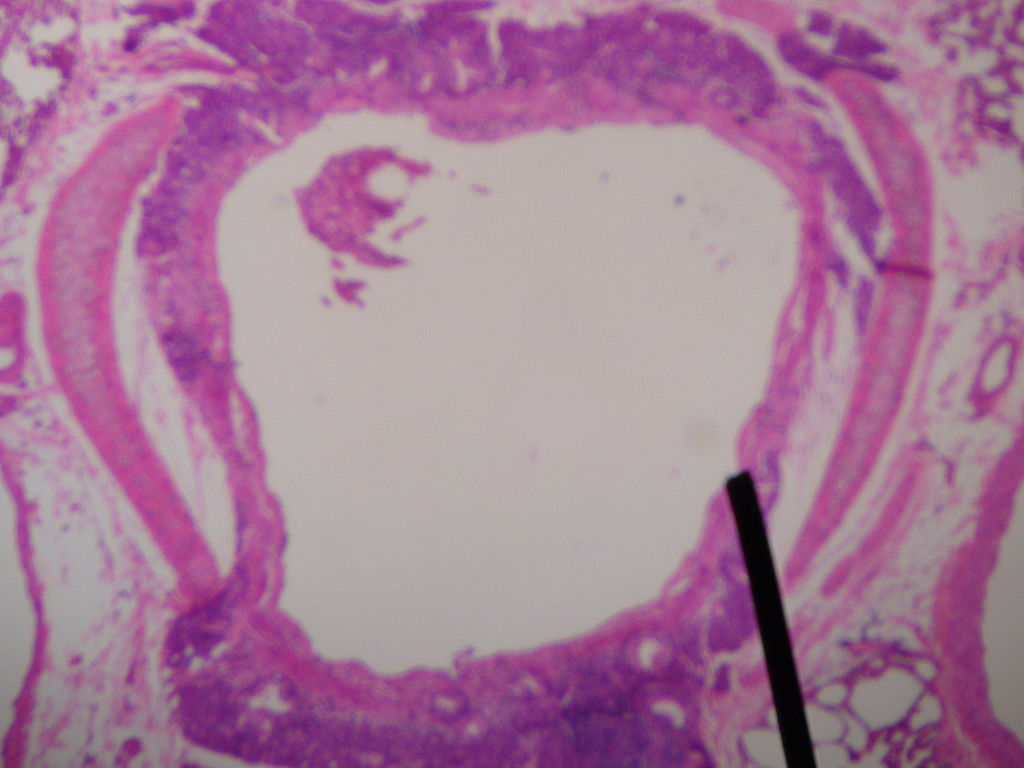Playlist
Show Playlist
Hide Playlist
Pulmonary Clinical Anatomy: Middle Portion
-
Slides OverviewOnDyspnea RespiratoryPathology.pdf
-
Download Lecture Overview
00:01 Move on. Here we go to the middle portion and the middle portion, we will explain upon this and we will do the same thing. As we go through it, we will move a little bit quicker. 00:07 Now, as we go through divisions up until seven and then eight, and that is an important point that you want to keep in mind here. Between seven and eight divisions, by that we mean generations of branches that are taking place. Well, now you notice that there is goblet cells. Well those goblet cells become important for us. Earlier, we talked about how wet mucous is and that is called Reid index, I repeat that again. This is still non-respiratory. 00:31 What does that mean? This is the conducting zone. It’s responsibility is to do what? To conduct air from the ambience into the alveoli. It is a strict responsibility. Here we have bronchioles and then once again, we will find these to be the conducting airways. 00:49 Let's take a look at the infections here again. Well, number 2 represents the most common cause of pneumonia in children, virally. This is respiratory syncytial virus. A child, well, what about a child? Where are they playing perhaps? Especially, nowadays, right. Parents are so busy that they can’t take care of their children and it is just the fact of life. And so therefore, early on, you start placing the child in a daycare center, I have be careful, and not say nursing home, but a daycare center. So, you place the child in a daycare center, they are playing around and they might get exposed to a lot of people, of course. And so, during that time, couple of things that a child develops quite commonly would be a pneumonia or respiratory issues and then also diarrhoea as well. Interesting enough, both diarrhoea and the pneumonia, that we are seeing here, virally, both begin with a letter “R”, So, we have respiratory syncytial virus, virally caused pneumonia in a child and we have rotavirus. No way, and that is a diarrhoea, rotavirus. There is bronchopneumonia, as we said, more distally, and bronchopneumonia it’s a fact that you have infection in the bronchi. Here, Klebsiella pneumonia becomes our primary example. 02:02 Diseases. Here we have asthma. With asthma, the one that is all too common in our society is atopic type of asthma. Atopic type of asthma is one in which the individual has been exposed to environmental allergens. Okay, that is one. And then you have the intrinsic. And by intrinsic, we mean what? Much less common, but may be perhaps you have an adult who, upon exposure to the cold, has asthma-like symptoms. What is this? Is it part of your? It could be part of your chronic obstructive pulmonary disease. 02:36 The three that have quite a little bit of overlap with signs and symptoms include, once again, asthma, chronic bronchitis and emphysema. We will take a look at where I'll show you shades or circles in which we have overlapping signs and symptoms. And then, of course, chronic bronchitis, we talked about as well. And with all that inflammation, at some point, you might cause complete destruction, annihilation of that bronchi and difficulty with getting air out. So, when we say obstruction, are we referring to difficulty with getting the air in? Not at all. It is difficulty with getting air out. For example, how can I prove that? Is emphysema COPD? Of course, it is. And tell me about your anteroposterior diameter or anteroposterior size. It is enlarged, isn’t it? And it is because, once again, air is being trapped in your lungs. It is important that you pay attention to the organization and as you go through here, get a nice little overview, don’t you, of your infections and diseases.
About the Lecture
The lecture Pulmonary Clinical Anatomy: Middle Portion by Carlo Raj, MD is from the course Introduction to Pulmonary Pathology.
Included Quiz Questions
What is the most common causal agent of pneumonia in children?
- Respiratory syncytial virus
- K. pneumoniae
- S. aureus
- Parainfluenza virus
- P. aeruginosa
What is the stimulus which triggers atopic asthma?
- Exposure to allergens
- Exposure to the cold
- Exercise
- Aspirin
- Smoking
Which of the following characteristics of obstructive disease is a hallmark sign of air trapping in the lungs?
- Increased AP diameter of the chest
- Productive cough
- Increased Reid index
- Increase risk of developing bacterial pneumonia
- Sensitivity to allergens
Customer reviews
5,0 of 5 stars
| 5 Stars |
|
5 |
| 4 Stars |
|
0 |
| 3 Stars |
|
0 |
| 2 Stars |
|
0 |
| 1 Star |
|
0 |






